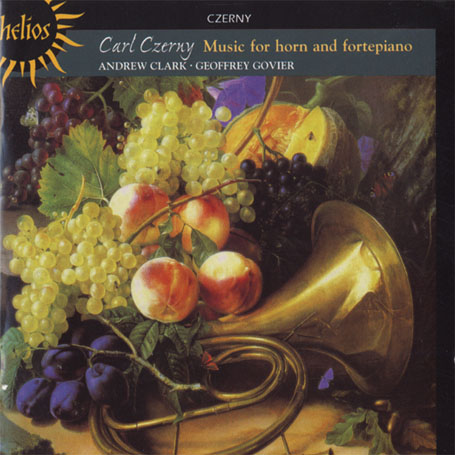Czerny Music for Horn & Fortepiano
This bargain-priced reissue presents some of Czerny’s chamber music in excellent period performances
View record and artist detailsRecord and Artist Details
Composer or Director: Carl Czerny
Label: Helios
Magazine Review Date: 11/2000
Media Format: CD or Download
Media Runtime: 80
Mastering:
DDD
Catalogue Number: CDH55074

Tracks:
| Composition | Artist Credit |
|---|---|
| Andante and Polacca |
Carl Czerny, Composer
Andrew Clark, Horn Carl Czerny, Composer Geoffrey Govier, Fortepiano |
| (3) Brilliant Fantasies on favourite themes from S |
Carl Czerny, Composer
Andrew Clark, Horn Carl Czerny, Composer Geoffrey Govier, Fortepiano |
| Introduction and Variations Concertantes |
Carl Czerny, Composer
Andrew Clark, Horn Carl Czerny, Composer Geoffrey Govier, Fortepiano |
Author: John Duarte
In this recording we have not only horn and fortepiano music but, also, the temporary turning back of a page of instrumental history. The natural horn was valveless and could (unassisted) play only the ‘bugle notes’, the natural harmonics; the other notes called for skilful manoeuvres by the player’s hand within the bell of the instrument. When Czerny wrote the Introduction et variations concertantes (c 1830) he specified the valved horn, but in the Brilliante Fantasien (c 1836) and Andante e Polacca (1848) he reverted to the natural horn. The possible reasons for this are discussed at length in Andrew Clark’s notes; they relate to the tonal differences between open and hand-stopped notes on the natural horn, and to the development of a more agile hand-stopping technique, the former beneficial to the shaping of melodic lines (the Fantasien are based on songs of Schubert) and the latter to the execution of florid passages. The term ‘florid’ is of course relative, and even the most agile passages for the horn are eclipsed in brilliance (though not in dramatic effect) by Czerny’s coruscating writing for the piano.
There are other worthy recordings of all but the Introduction et variations concertantes, but this is the only one to use period instruments, telling it like it sounded in the salons of its time, executed with great skill and artistry, and finely recorded. The sound of the fortepiano is lighter and less three-dimensional than that of today’s instrument, and the notes in its highest register teeter on the brink of becoming percussive rather than pitched – but just manage to avoid crossing the line. For devotees of the horn music and salon music of the first half of the 19th century this is an essential addition to their collections, and an interesting one for music-lovers in general.'
There are other worthy recordings of all but the Introduction et variations concertantes, but this is the only one to use period instruments, telling it like it sounded in the salons of its time, executed with great skill and artistry, and finely recorded. The sound of the fortepiano is lighter and less three-dimensional than that of today’s instrument, and the notes in its highest register teeter on the brink of becoming percussive rather than pitched – but just manage to avoid crossing the line. For devotees of the horn music and salon music of the first half of the 19th century this is an essential addition to their collections, and an interesting one for music-lovers in general.'
Discover the world's largest classical music catalogue with Presto Music.

Gramophone Digital Club
- Digital Edition
- Digital Archive
- Reviews Database
- Full website access
From £8.75 / month
Subscribe
Gramophone Full Club
- Print Edition
- Digital Edition
- Digital Archive
- Reviews Database
- Full website access
From £11.00 / month
Subscribe
If you are a library, university or other organisation that would be interested in an institutional subscription to Gramophone please click here for further information.




